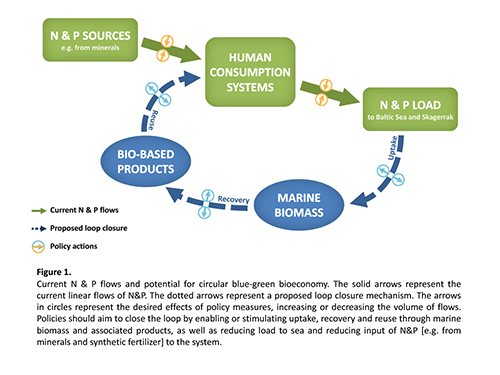Marine bioeconomy for circular nitrogen and phosphorus flows in Sweden: Alternatives, hurdles and policy tools
Circular flows of nitrogen and phosphorus are desirable for several reasons, though bioeconomy activities that provide this valuable externality may not be recognised, supported or encouraged for doing so. This project explores and compares current and future bioeconomy activities that can contribute to the recovery and reuse of nitrogen and phosphorus.

Project name and -number: Marine bioeconomy for circular nitrogen and phosphorus flows in Sweden: Alternatives, hurdles and policy tools (Formas 2017-00213)
Project leaders: Jean-Baptiste Thomas and Linus Hasselström, SEED
Participating universities/companies/other organisations: KTH Royal Institute of Technology, Anthesis, Tyréns and IVL
Project period: 2018-2021
Financing: Formas
Circular flows of nitrogen (N) and phosphorus (P) are desirable for several reasons. The planetary boundaries with respect to these nutrient cycles have been exceeded beyond a safe operating space, which results in a number of environmental pressures and sustainability concerns. Notably, food security and society as a whole depend on finite mineral P resources, which today are typically consumed in a linear manner, from mine to P sinks such as oceans and seas. Previous research has concluded that marine biomass such as micro- and macro- algae, reed and mussels have a high potential for taking up N and P. Development of products such as biogas, biofertilizer, polymers, food etc., has the potential to also bring about recovery and reuse of N and P. There may be room for a marine bioeconomy which both contributes to economic growth and to the closure of N and P loops while also alleviating eutrophication along the Swedish coast. However, there are many challenges and pitfalls; policy may have to adapt in order to sustain these activities.
In this project, we provide a birds-eye perspective on developments in Sweden, including specific case-studies, visions, hurdles, and potential enabling policies. The project includes assessments of suitable biomass and products and quantification of N and P flows using element flow analysis; assessment of economic potential; stakeholder mapping and hurdle analysis; and the mapping of policy options. The team is interdisciplinary consisting of researchers specialized in life cycle assessment and material flow analysis, environmental economics, gender equality, marine ecology, governance, social impact assessment, and environmental policy.
